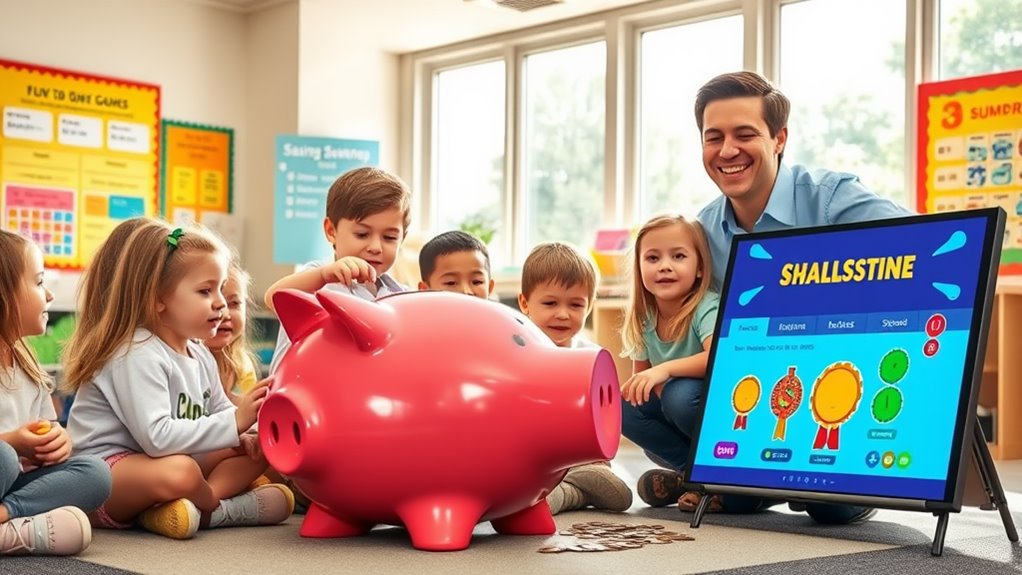5 Ways to Teach Kids About Money Management
Teaching kids about money management can be fun and effective. Start by using a savings jar, letting them see their money grow towards a goal. Introduce budgeting games to make learning about financial literacy enjoyable. Setting up a mock store allows them to practice transactions and math skills. Discussing needs versus wants helps them prioritize spending wisely. Finally, encourage earning opportunities through allowance jobs or entrepreneurial ventures to teach the value of hard work. These strategies can lay a solid foundation for their financial future, and there’s much more you can explore to further enhance their understanding.
Key Takeaways
- Use a savings jar to visualize savings growth and set clear financial goals for kids.
- Introduce budgeting games to make learning about money management engaging and fun.
- Set up a mock store to teach kids about transactions, budgeting, and the value of money.
- Teach kids the difference between needs and wants to prioritize spending effectively.
- Encourage earning opportunities through allowance jobs and entrepreneurial projects for real-world experience.
Use a Savings Jar
Using a savings jar can be a simple yet effective way to teach kids about money management. It provides a tangible method for them to see their savings grow, making the concept of saving more engaging.
Start by discussing savings goals with your child. Whether it’s for a new toy, a special outing, or even a larger item, having a clear target helps them understand the importance of saving.
Next, set up the jar in a visible spot. This serves as a constant reminder of their goal and encourages them to contribute. You can use stickers or colored markers to visually track their progress. For example, if their goal is $50 for a new game, they can mark each dollar saved with a sticker until they reach their target.
Encourage them to save part of their allowance or any money they receive as gifts. This practice cultivates a sense of responsibility and discipline.
Over time, they’ll not only learn about saving but also gain a sense of accomplishment as they watch their savings jar fill up, reinforcing the idea that patience and effort lead to achieving their savings goals.
Introduce Budgeting Games
As kids start to grasp the concept of saving with their savings jar, introducing budgeting games can further enhance their understanding of managing money. These games make learning about financial literacy fun and engaging, allowing your kids to practice budgeting in a playful environment. You can find various board games designed for money management, or consider digital options like budgeting apps that simulate real-life financial decisions.
By playing these games, kids learn how to allocate resources, prioritize spending, and recognize the value of saving. They’ll encounter scenarios like unexpected expenses, which will teach them to think critically about their financial choices. This hands-on experience is invaluable, as it helps them develop a mindset for responsible money management.
Moreover, you can turn budgeting into a family activity by setting up friendly competitions. Challenge your kids to stick to a budget during a game night or even plan a small family outing using a budget.
These activities not only reinforce their budgeting skills but also create lasting memories. So, dive into budgeting games and watch your kids’ financial literacy grow as they learn to manage money in a fun and interactive way!
Set Up a Mock Store
Setting up a mock store can be a fantastic hands-on approach to teach your kids about money management. Create a space in your home where kids can shop and sell using play money. You can use items from around the house as products, labeling them with prices. This way, your kids can learn about the value of money while having fun.
Assign store roles to each child—some can be cashiers, while others can act as customers. This helps them experience both sides of a transaction. As cashiers, they’ll practice counting and giving change, which reinforces math skills. Customers will learn to budget their play money and make decisions about what they can afford.
Encourage discussions about pricing and the value of items. Ask questions like, “How much do you think this should cost?” or “What will you buy with your play money?” This encourages critical thinking about money management.
Teach About Needs vs. Wants
After experiencing the fun of a mock store, kids can gain a deeper understanding of financial decision-making by learning the difference between needs and wants.
Start by explaining that needs are essentials for survival—like food, clothing, and shelter—while wants are things that add joy or comfort, like toys and gadgets.
Encourage them to do a value assessment by listing items they desire. Have them categorize each item as a need or a want. This exercise helps them grasp the importance of financial priorities.
Discuss why it’s crucial to meet needs first before indulging in wants. It’s a valuable lesson in budgeting and setting limits.
You can also give them scenarios where they must choose between a need and a want. Ask, “If you’d $10, would you buy a nutritious snack (need) or a candy bar (want)?”
This encourages critical thinking and reinforces the concept of prioritization.
Encourage Earning Opportunities
While it’s important for kids to understand the difference between needs and wants, encouraging them to seek earning opportunities can further enhance their financial literacy. One way to do this is by introducing them to allowance jobs. These jobs can range from simple household chores to more extensive tasks like pet sitting or lawn mowing.
By offering a set allowance for completing these jobs, you not only teach them the value of hard work but also give them a sense of accomplishment.
Additionally, consider supporting entrepreneurial projects that spark their interest. Whether it’s setting up a lemonade stand, crafting homemade jewelry, or offering tutoring services, these ventures provide real-world experience in budgeting, pricing, and customer interaction.
Encourage your kids to brainstorm ideas and develop a plan to bring their projects to life.
Frequently Asked Questions
At What Age Should I Start Teaching Kids About Money?
You should start teaching kids about money as early as preschool. By age milestones like 5 or 6, early lessons can set a strong foundation, helping them understand value, saving, and responsible spending as they grow.
How Can I Make Money Management Fun for Younger Children?
Did you know kids who play money games show improved financial skills? To make money management fun, try engaging them with savings challenges and interactive activities that encourage creativity and teamwork while learning valuable lessons.
What Are Some Good Online Resources for Teaching Kids About Finances?
For teaching kids about finances, check out engaging financial games and budgeting apps like Greenlight or GoHenry. These resources make learning about money interactive, helping them grasp important concepts while having fun.
How Do I Explain the Concept of Interest to Children?
Think of interest as a snowball rolling down a hill, growing bigger. Explain how compound interest helps savings goals by showing them how money can multiply over time, making their savings grow faster than they’d expect.
What Should I Do if My Child Struggles With Budgeting?
If your child’s facing budgeting challenges, offer parental guidance by breaking down expenses into smaller categories. Encourage them to track spending, set achievable goals, and celebrate small successes to build confidence in their budgeting skills.





